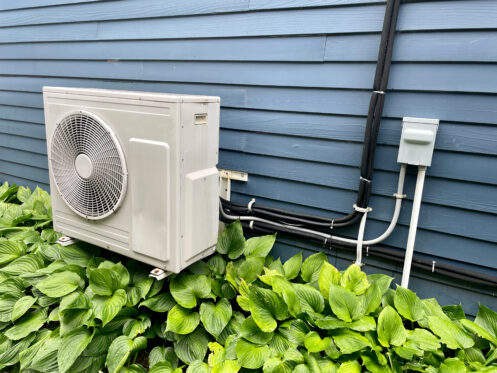A ductless mini-split is a type of heating, ventilation, and air conditioning system. Ductless refers to the fact that it doesn’t need ductwork in the home. Instead, each indoor unit has its own blower. The ‘split’ in mini-split indicates that it’s a split rather than packaged system. In other words, there is a unit outside your St. Louis, MO, home, and one or more indoor units. Manufacturers design these systems to take up as little space in the home as possible. There are many other benefits as well.
Few Installation Requirements
Ductless mini-splits are suitable for most homes. That includes older homes that don’t already have ductwork. The only real requirement is that the installer must be able to run a 3-inch conduit. The conduits connect the outdoor condenser unit to each indoor air handler.
Fast Installation
The installation process for a ductless mini-split is simple and quick compared to other HVAC equipment. Installers complete most installations, even in larger homes, in under a day. In fact, the average mini-split installation takes between four and six hours.
Cooling and Heating
There are two types of ductless mini-splits: ductless air conditioners and ductless heat pumps. Ductless ACs provide cooling only. Ductless heat pumps provide cooling and heating. This is possible through a reversing valve that lets the heat pump exchange air in the other direction as well. Having the option for heat too means that you can choose a ductless mini-split as a whole-home solution.
High Energy Efficiency
Ductless mini-splits are among the most efficient cooling and heating solutions on the market. The U.S. Environmental Protection Agency uses two rating systems. The seasonal energy efficiency ratio (SEER) measures cooling efficiency over an entire cooling season. The heating seasonal performance factor (HSPF) measures heating efficiency over an entire heating season.
The minimum SEER rating in the St. Louis region for a mini-split is 14.0. The minimum HSPF rating is 8.2. When comparing a mini-split to central AC, for instance, you have to factor in energy loss through the ductwork. The central system will lose about 30% of its energy that way. This is where SEER2 and HSPF2 come in. They are newer versions of the ratings that account for static air pressure.
Lower Month-to-Month Costs
Because a ductless mini-split is 30% more efficient than central air, you’re going to save from month to month. A ductless heat pump is also much more efficient than a furnace or boiler. The average home spends about $1,350 annually on heating and cooling. Using that figure, monthly savings are about $34.
Reduced Carbon Footprint
Did you know that your HVAC system accounts for the bulk of your household’s carbon footprint? Many people think it’s their automobiles, but that isn’t the case. Air conditioning, in particular, isn’t just an American problem. It’s a global one, and it’s growing. Worldwide air conditioning use already produces four times as many greenhouse gases as the entire aviation industry combined. According to the EPA, not only choosing a mini-split but also an Energy Star mini-split makes a big difference. Those homeowners will reduce their greenhouse gas emissions by 4,500 pounds, on average, over the life of the system.
Low Noise Levels
Ductless mini-splits are among the quietest HVAC solutions on the market. Ducts are often a big contributor to HVAC noise. Manufacturers have also put a great deal of effort into designing quiet indoor units. Most modern mini-splits produce 20 to 25 decibels, which is about the noise level of a whisper.
Airflow Control
Another common concern customers new to mini-splits have is airflow. You won’t have to worry about air blowing directly at you. Most modern systems have at least manual airflow control. Many of the top models also have motion sensors that automatically keep air from blowing directly on people. You can also set it to the reverse, which is nice, for instance, when you’re working out.
Remote Control and Wi-Fi Capabilities
Practically all mini-splits come with a remote that lets you control settings without having to get up from the spot that you’re in. In years past, a limitation was that you needed one remote per unit. Having a remote wasn’t much good if you had to walk into the bedroom to use it. This is no longer an issue, thanks to Wi-Fi. Most mini-split remotes have Wi-Fi capabilities. Most brands also have an app, which lets you ditch your remote in favor of your smart phone or tablet.
Integrated HVAC Zoning Options
Upgrading a central HVAC system to zoning is often complicated and expensive. All multi-zone ductless mini-split systems are inherently zoned. Each indoor unit provides conditioned air to its zone. This provides additional energy savings because you can maintain a more energy-efficient setting in the zones you’re not using.
Flexible Mounting Options
Wall mounting is the traditional installation option for mini-splits and remains the most popular. You can install them on the ceilings and floors instead. Many brands now make cassette designs for the ceiling. This eliminates many of the older challenges of installing these units on the ceiling.
Expandable
If you opt for a multi-zone mini-split, you have the option to expand later. Your only limitation is the upper head limit of the system, which is typically eight. If you install a system with four heads, you still have room for four more heads down the line.
Suitable as a Central Air or Forced-Air Add-On
Mini-splits are suitable either as a standalone solution or as an add-on to a central system. A common example is adding mini-splits to your bedrooms. This allows you to maintain comfortable sleeping temperatures while saving money throughout the rest of the house.
Suitable for Disconnected Living Spaces
Mini-splits are also a great way to provide cooling and heating to living areas not easily reached by the main system. Examples include apartment garages, detached garages, home additions, and work sheds. You can also use them in areas like sunrooms to lower the burden on your central system.
Federal Tax Credit
The EPA certifies most mini-splits on the market through its Energy Star program. Choosing an Energy Star mini-split may make you eligible for the energy efficient home improvement credit. It’s available through 2030. It lets you claim 30% of equipment and installation costs up to 30%.
Local Energy Rebates
The EPA website also lists energy rebates that you can claim. These are specific to your area and offered by utility companies, local government agencies, nonprofits, and so forth. You can utilize multiple rebates if they’re available. Rebates also lower your costs sooner. With the tax credit, you must wait for tax time.
Local Ductless Mini-Split Experts
If you live in St. Louis or throughout the surrounding area and want a ductless mini-split installed, Agers Heating & Air Conditioning can help. Our HVAC technicians also specialize in boilers, radiant heating, heat pumps, air conditioners, and furnaces. We also have indoor air quality experts that specialize in air purifiers, dehumidifiers, and humidifiers. Call us today, or contact us online with any questions about these services or to schedule an appointment.




